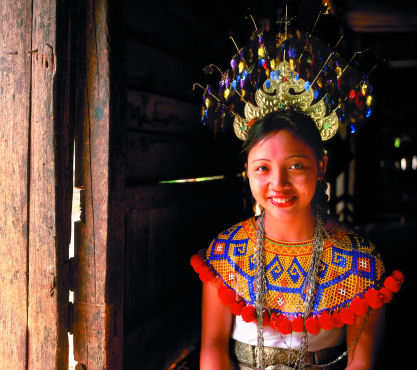
Closely connected with the death cult is the headhunting activities of the Iban long ago. In the past, head trophies ( antu pata ) were secured to ceremonially end the long and strict period of mourning after a death. Other important occasion which required the acquisitions of head trophies include-- the death of leader, and the birth of a child, especially a male child. Head trophies were also acquired during bejalai missions of tribal warfare. The acquisition of head trophies was a sign of valour in battle and brought prestige to the conquering warrior.
In Sarawak, the dominant tribal groups are the Dayak. Tribal people live in longhouses. There are the Iban (Sea Dayak), and the Bidayuh (Land Dayak). All of Malaysia’s tribal people feel a strong spiritual connection to the rainforest. The Iban grow rice and fruit, and hunt and fish.The Ibans form the largest percentage of Sarawak's population, making up some 30% (= 400,000 people). Reputed to be the most formidable headhunters on the island of Borneo, the Ibans of today are a generous, hospitable and placid people. Because of their history as pirates and fishermen, they were conventionally referred to as the "Sea Dayaks".
The Iban is a friendly and hospitable tribe. The majority of Sarawak Ibans, especially in the lowlands, are living mostly in  longhouses along the main rivers and their tributaries. They are Christians, but they still maintain their strong cultural identity and heritage. The Ibans are also famous for their tuak, a sweet rice wine, which is served during big celebrations and festive occasions. Please bare in mind, that whenever you visit a longhouse, at the entrance you will be given a glass of tuak for warm welcoming and never say no, because if you resist you are not respecting their kind offer.
longhouses along the main rivers and their tributaries. They are Christians, but they still maintain their strong cultural identity and heritage. The Ibans are also famous for their tuak, a sweet rice wine, which is served during big celebrations and festive occasions. Please bare in mind, that whenever you visit a longhouse, at the entrance you will be given a glass of tuak for warm welcoming and never say no, because if you resist you are not respecting their kind offer.
An Iban boy starts to use the implements of the wood-worker and carver from an early age.The decorated bamboo containers are sign of a bachelor's affection for a young, unattached women as well as being a mark of his own accomplishment and refinement. Once an a serious affair started beyond the first largely physical attraction, the young man carves a decorated bamboo container as a permanent token of his affection. Once married, the Iban groom either moves to his wife's family or the bride moves to the husband's family.
Iban man and his prize winning fighting cock
An Iban is a member of a bilek family, which in turn is one unit of a longhouse. About two years after the marriage, especially if a child has been born, the couple will move out of the parental unit to start its own bilek (strictly a bilek is an unit in a long house, but the word also denotes a discrete family unit within a longhouse). It is the man's role to protect his family and fields from terrestrial and extraterrestrial pests & predators.Farming is a critically important activity for the Iban family, because it provides the substance which keeps them alive.

Smiling Iban maiden
 Iban have many festivals called 'Gawai'. There are the 'Gawai Kenyalang' (hornbill festival), 'Gawai Antu' (festival for the dead) and 'Gawai Dayak' (harvesting festival). During such festivals, besides the customary observance of ritual, there is usually much drinking of the locally brewed rice wine called 'tuak', much merriment and dancing called 'ngajat' and displays of elaborate traditional costumes.
Iban have many festivals called 'Gawai'. There are the 'Gawai Kenyalang' (hornbill festival), 'Gawai Antu' (festival for the dead) and 'Gawai Dayak' (harvesting festival). During such festivals, besides the customary observance of ritual, there is usually much drinking of the locally brewed rice wine called 'tuak', much merriment and dancing called 'ngajat' and displays of elaborate traditional costumes.
Recipe Tuak
Tuak is our special rice wine. It is a drink for all occassions, be it Gawai, weddings or entertaining our visitors. Westerns who have had a taste of tuak, love it, and in some cases might smuggle it home too!
Preparation: Glutinous rice is cooked and left to cool in a 'tapan' or any flat utensils. For every 5 Kg of glutinous rice you will need 5 kg of round 'ragi' (yeast) and 5 pieces of thin slice ragi. (round ragi for bitterness, slice ragi for sweetness). The yeast are pounded into powder and mixed with the rice after it has cool. This mixture is then left to ferment in any clean container (jar) for a week or so. Cool, boiled water plus sugar (syrup) is added to this mixture. (10 kg sugar for 20 liters of water) Depending on your taste, your tuak is now ready. if you prefer you can wait another week. The longer you keep your tuak the more portent it will be.
In recent decades much of their rainforest has been cleared by logging and plantation companies. The Iban and other tribes have frequently blockaded logging roads to try to protect their forest.
In many Iban longhouses you find only old people and young children. I got the feeling that the whole community is reduced to an exhausted past, and an uncertain future.Naturally, without the younger generations to inherit their rich cultural legacies, but traditions are dying. The ancient crafts of making boats, building longhouses, weaving, dancing, tattooing, and native art are now dying fast. Even the whole oral tradition of telling tales and myths is disappearing.

Native Iban hunting nearby a waterfall in Batang Ai.


No comments:
Post a Comment